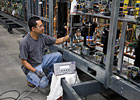
Battery powered nitrogen/hydrogen leak detectors can be used on site.
Leak detectors are a familiar part of a technician’s arsenal of service equipment. Sometimes familiar leak technology gets tweaked. That was the case when Hill Phoenix, a manufacturer of refrigeration systems for commercial installations, was looking for a way to deal with the rising costs of helium, a gas commonly used in leak detection.
According to officials at Alcatel Vacuum Products, Hill Phoenix was using helium to test for leaks in its units, but gas prices were escalating and supply restrictions drove them even higher. With the cost of helium projected to continue to rise for the foreseeable future, the company sought alternative ways to achieve the objective of ensuring tight systems.
The refrigeration equipment manufacturer had been using helium leak detectors to ensure that welded joints, mechanical joints, and externally supplied components were tight and would not allow any refrigerant to escape. Specifications allow a loss of only 0.1 ounces per year to ensure the installed refrigeration system will remain reliable for many years.
The company created a task force, led by senior procurement engineer Philip Stephenson, to investigate what options were available to both reduce the cost and solve the supply issues associated with helium.
The team’s initial suggestion was to reduce the amount of helium used, either by reducing the concentration of the gas or by installing helium reclaim units. But Hill Phoenix officials said they found problems with these ideas; for instance, reducing the gas concentration made the detectors less sensitive in finding leaks, creating the chance of reduced product quality.
A SOLUTION
The company then called upon its existing helium leak detector supplier, Alcatel, to help find a solution to reduce short- and long-term costs, with no negative impact on leak detection capabilities. The meeting with Alcatel led to the suggestion of using diluted hydrogen as an alternative leak-testing gas.“We obviously had some initial reservations about the use of hydrogen within the plant, and the use of new detection technology, but the proposal by Alcatel was cost attractive and worth additional scrutiny,” Stephenson said.
The test gas was a mixture of 95 percent nitrogen and 5 percent hydrogen which, according to ISO 10156, is a safe, nonflammable, green-labeled gas. According to Alcatel, the test gas mixture was available and inexpensive. Having established that the gas was safe to use and would save potentially hundreds of thousands of dollars annually, Hill Phoenix decided to evaluate it further.
“It was important to us not only that the detectors would prove to be reliable and detect the smallest of leaks in production, but also that all of our staff and operators agreed and accepted the change,” Stephenson said.
Alcatel’s Adixen H2000 ICE leak detector was put through the paces at the plant. It was rotated through phases of the production process and used by each of the assigned operators. “The unit performed well during the evaluation period and passed all of our tests,” Stephenson said.
The next stage was a final cost justification and deciding how the gas would be supplied. The supply question revolved around mixing the gas on site - which required bulk storage of nitrogen and hydrogen - or having tube trailers supplied with premixed gas.
“For Hill Phoenix the tube trailer option made the most economic sense,” Stephenson explained. “The company was already using tube trailers with helium so the conversion would be simple and effective.”
When the company realized it would save almost $300,000 every year without the added burden of mixing the gas at the plant, it wrote a purchase order initially for 15 leak detectors, then ordered an additional seven leak detectors.
“The new leak detectors have been running at our production facility for a few months now, and our decision to change has been fully justified,” Stephenson said.
ON SITE
At installation sites such as supermarkets, the refrigeration systems have final assembly joints to connect to the individual refrigeration cases, which means additional leak testing is needed. Hill Phoenix purchased four battery versions of the detectors for that type of situation and is able to test its larger refrigeration systems at the site.Previously, the leak test method on site was to first vacuum test the refrigeration system for a few hours, then if no leaks were indicated by a pressure rise, it was pressurized with the refrigerant.
Now, according to Alcatel, pretesting the completed refrigeration system with nitrogen and hydrogen finds the significant leaks that the pressure test does not and also pinpoints the leak site. Repairs and rechecking can often be made without venting the gas.
Additional benefits from the switch from helium leak testing to testing with the new detector that uses N2/H2 gas mixture:
• Solid-state detection technology requires no scheduled maintenance because there are no probes to clean and no valves and pumps to service.
• There is a fast response time to a leak independent of the probe cable length.
• There is fast pinpointing and no downtime from background contamination, because the gas mixture dissipates quickly.
• Hydrogen does not cloud like helium, so large leaks can be pinpointed without the need to use soap solutions.
“Switching from leak testing with helium to leak testing with diluted hydrogen has been all positive for us,” Stephenson said. “We have reduced our costs, retained our product quality, and reduced our time to find large leaks. And we anticipate that we will be helping the environment by reducing refrigeration leaks at the installation site.”
For more information, visit www.adixen-usa.com.
Publication date:11/03/2008

Report Abusive Comment